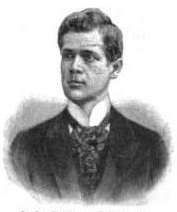Otto zur Strassen
Otto Karl Ladislaus zur Strassen (born May 9, 1869 in Berlin ; † April 21, 1961 in Oberstedten , Taunus ) was a German zoologist .
Life
Otto zur Strassen was born in Berlin in 1869 as the son of the sculptor Melchior zur Strasse . In 1871 his family moved to Nuremberg and in 1876 to Leipzig . He attended the humanistic Thomas School in Leipzig from 1877 to 1887 .
After graduating from high school, he studied natural sciences , especially biology , at the University of Leipzig and Albert Ludwig University in Freiburg . From 1887 he was a member of the Normannia fraternity in Leipzig. In 1892 he received his PhD in biology Bradynema rigidum in Leipzig as Dr. phil. PhD. From 1892 to 1894 he made trips to Naples to the zoological station and to Russia . In 1894 he was a one-year volunteer in the Saxon Army . In 1896 he completed his habilitation in zoology with the work Gestaltungsvorgänge an Ascaris and became a private lecturer in special zoology at the University of Leipzig. After taking part in the Valdivia expedition to explore the deep sea in 1898/99 and returning to Leipzig in 1899, in 1901 he became associate professor for special zoology at the University of Leipzig. In 1903 he became an extraordinary member of the Saxon Academy of Sciences .
From 1909 to 1934 he was director of the Senckenberg Museum (as the successor to Fritz Römer, who died in 1909 ) in Frankfurt am Main. From 1914 to 1937 he was the first full professor of zoology and comparative anatomy and director of the zoological institute at the newly founded University of Frankfurt . His focus was on morphology and development mechanics . In 1922/23 he was rector of the university. In 1934, after disputes in the museum, he resigned from his position as museum director. In 1937 he retired as a university professor. He was a popular university professor - in 1959 he was honored with a torchlight procession by the students of Frankfurt University on his 90th birthday.
Zur Strassen had the title of a secret councilor .
From 1911 to 1918 he was editor of the fourth, completely revised edition of Brehms Tierleben (reference work).
family
Otto zur Strassen was married twice and had six children. His eldest son from his second marriage was the zoologist Richard zur Strassen (1926–2013), the second oldest son Hermann was a sculptor.
His sister Else zur Strassen married the lawyer and chemist Edmund Kloeppel in 1897 .
Fonts (selection)
- The history of the T-giants of Ascaris megalocephala as the basis for a development mechanism of this species, Stuttgart 1906.
- Plastic-looking eye-spots and the "Sexual Selection", Jena 1935.
- New contributions to the development mechanics of nematodes, Stuttgart 1959.
Web links
- Literature by and about Otto zur Strassen in the catalog of the German National Library
- Overview of Otto zur Strassen's courses at the University of Leipzig (summer semester 1896 to winter semester 1909)
- Otto zur Strassen in the professorial catalog of the University of Leipzig
Individual evidence
- ↑ Richard Sachse , Karl Ramshorn, Reinhart Herz: The teachers of the Thomasschule in Leipzig 1832-1912. The high school graduates of the Thomas School in Leipzig 1845–1912 . BG Teubner Verlag, Leipzig 1912, p. 77.
- ↑ Willy Nolte (Ed.): Burschenschafter Stammrolle. List of members of the German Burschenschaft according to the status of the summer semester 1934. Berlin 1934. p. 488.
- ^ Deceased old gentlemen of the Normannia-Leipzig fraternity in Marburg
- ^ Members of the SAW: Otto zur Strassen. Saxon Academy of Sciences, accessed December 5, 2016 .
- ↑ Curt Herbst (1866 - 1946) also belonged to the so-called "Neapl Development Mechanics", so-called because of their temporary research in the zoological station.
- ↑ Peters Otto zur Strassen , in 175 years Senckenbergische Naturforschende Gesellschaft , anniversary volume , Senckenberg books Volume 67, 1992, pp. 325-330
- ↑ Biography of zu Strassen in Sabine Ruhe's dissertation on Fritz Drevermann , University of Frankfurt 2002
| personal data | |
|---|---|
| SURNAME | Strassen, Otto zur |
| ALTERNATIVE NAMES | Strassen, Otto Karl Ladislaus zur (full name) |
| BRIEF DESCRIPTION | German zoologist |
| DATE OF BIRTH | May 9, 1869 |
| PLACE OF BIRTH | Berlin |
| DATE OF DEATH | April 21, 1961 |
| Place of death | Oberstedten , Taunus |
